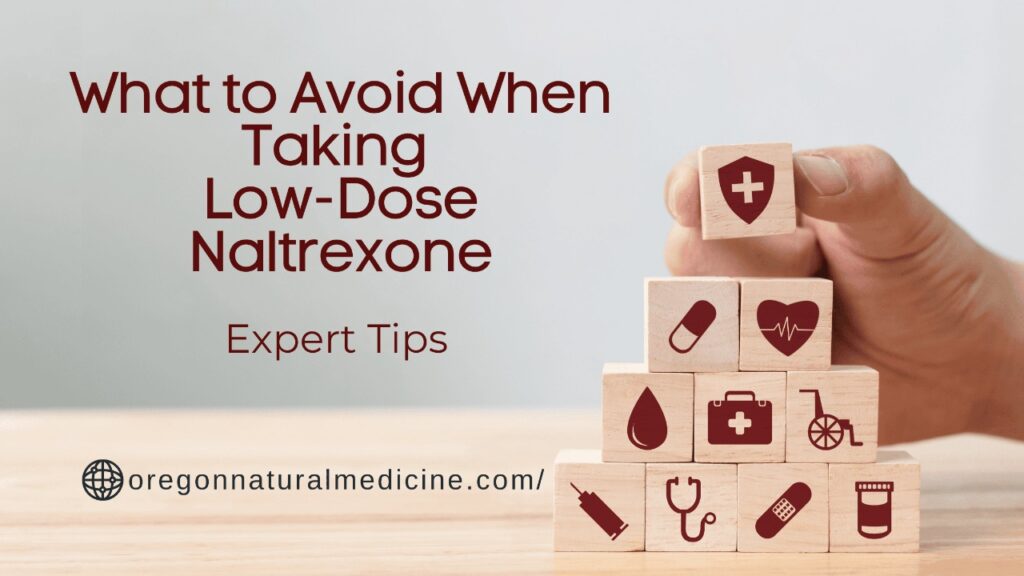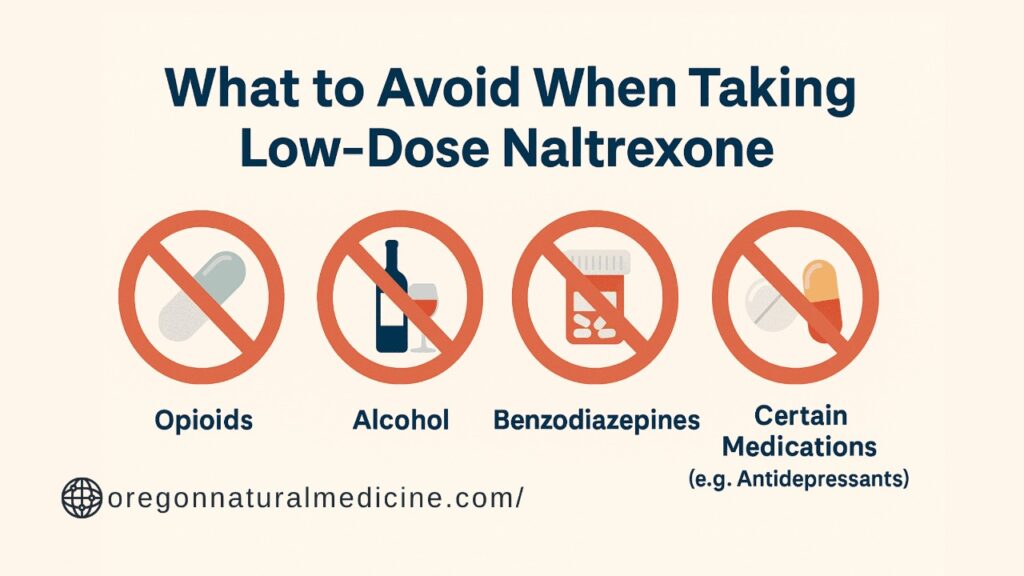
Low dose naltrexone (LDN) appears to be a promising therapeutic approach to chronic pain conditions, autoimmune disorders, and other immune-related diseases. But as with any medication, LDN should be taken carefully to prevent side effects.
Knowing what to avoid when using low-dose naltrexone can safeguard your health, help you achieve better results, and prevent any naltrexone drug interactions. Certain medications, alcohol, opioids, and immune-suppressing drugs are just some of the substances and habits that might get in the way of your treatment.
This guide will save you from complications and increase your chances of success, both by answering common questions and by keeping you up to date with naltrexone interactions, side effects, how it works, and how to take low-dose naltrexone safely. Let’s dive in.
Naltrexone is an FDA-approved treatment for alcohol use disorder (AUD) and opioid use disorder (OUD). It functions by blocking the opioid and endorphin receptors in the brain, which diminishes the “high” that individuals experience when they consume drugs or alcohol. This can help reduce your cravings for drugs.
It’s generally taken as a prescription in doses of 50–100 mg for addiction recovery. It is available as a tablet or an injection. It is not addictive like narcotics.
LDN helps by calming an overactive immune system. In many autoimmune diseases, the immune system starts attacking the body’s own tissues. LDN supports the work of T regulatory cells (Treg cells), which are like peacekeepers. They help turn inflammation on or off when needed. This creates better immune tolerance and limits immune dysregulation.
LDN also improves the functionality of T regulatory cells / Treg cells. These cells keep your immune system balanced. When they malfunction, it results in immune dysregulation. It’s the root cause of autoimmune conditions like Hashimoto’s thyroiditis, lupus, and Graves’ disease.
LDN also stops the over-activation of microglia. These are immune cells in the brain that cause inflammation in the central nervous system, neurotoxicity, and symptoms such as fatigue or brain fog.
Low-dose naltrexone (LDN) is what it sounds like — naltrexone taken in low doses, typically 1 to 5 mg. It is used for off-label medication uses, including in people with chronic pain, fibromyalgia, Crohn’s disease, and more.
Although it’s not FDA-approved for these uses, many doctors include it in a personalized treatment program. The research is still in progress about it, but results from patients have been favorable so far.
LDN acts as a temporary opioid receptor blocker. As it starts to wear off, your body compensates by releasing more endorphins, which regulate immunity and relieve pain.
It also calms glial cells in the nervous system as well. That’s less pain sensitivity, lower inflammation, and fewer flare-ups for those with autoimmune problems.
Summary Table: How LDN Works
Function | Impact |
Blocks opioid receptors | Triggers natural endorphin release |
Boosts endorphins | Reduces inflammation, improves mood |
Calms glial cells | Less pain, better nerve health |

Using low-dose naltrexone (LDN) safely means knowing which substances and medications to avoid. Some combinations can weaken its effects, while others can cause serious side effects. Let’s break it down clearly:
1. Opioids
LDN blocks opioid receptors. If you take opioids with LDN, it can trigger sudden and severe opioid withdrawal symptoms like nausea, vomiting, diarrhea, and body chills. This is not only uncomfortable but dangerous.
Avoid all opioids, including:
If you’ve used opioids recently, your doctor may delay LDN treatment. They might perform a naloxone challenge test or a urine drug screen first.
Statistical Evidence: A 29‑year‑old male mistakenly took 50 mg of naltrexone just minutes after IV heroin. This triggered precipitated opioid withdrawal—severe abdominal pain, vomiting, diaphoresis—requiring emergency care. (Harm Reduction Journal)
2. Alcohol
Wondering if you can drink alcohol while taking LDN? It’s not recommended. Naltrexone and alcohol together can increase your liver damage risk and reduce LDN’s effectiveness.
Even occasional drinking can:
Avoid alcohol to protect your health and help LDN do its job.
Statistical Evidence: A study published in a journal of psychiatric medicine indicated that elevated liver enzymes were observed in some patients who continued to drink while taking naltrexone. (NCBI)
Read more: How Low Dose Naltrexone Benefits Can Transform Your Autoimmune Treatment Plan
3. Benzodiazepines
These medications are used for anxiety or sleep, but can create problems when combined with LDN. Benzodiazepines (like Xanax, Valium, or Ativan) slow down your nervous system. When combined with LDN, they can increase fatigue, confusion, or sedation.
Only use these medications under close medical supervision.
4. Certain Medications (e.g., Antidepressants)
Some prescription and over-the-counter drugs can include hidden opioids. These may cause naltrexone drug interactions or accidental withdrawal.
Watch out for:
Always check labels and talk to your doctor before combining anything with LDN.
5. Immune Suppressants
LDN supports immune system regulation. But if you’re on medications that suppress immunity, like chemotherapy or steroids, it may interfere with your treatment.
This conflict can:
If you’re on immune suppressants, your doctor will determine if LDN is appropriate.
Before you start LDN, your doctor will need your medical history. That includes any recent surgeries, addiction history, or serious illnesses.
You may need liver tests, urine tests, or opioid screening.
LDN may not be suitable if you have:
Wondering “is LDN safe during pregnancy or breastfeeding”? There’s not enough data, so always consult a healthcare provider.
Start Slowly and Monitor
Start with a small dose—1 mg or less. Gradually increase over time if needed. This avoids vivid dreams from medication, anxiety, or other side effects.
Regular Checkups
Stay in touch with your doctor. Have regular blood work to check liver and kidney function. Adjust your dose if needed.
Consider Lifestyle Factors
LDN works best when paired with healthy habits:
LDN is not for everyone. You may need a different option if you:
Common side effects of LDN in autoimmune treatment:
Statistical Evidence:
Though rare, high doses or long-term use can lead to:
Statistical Evidence:
Always report side effects to your doctor immediately.
Potential Side Effect | Severity | Onset | Management Tips |
Headache | Mild | 1–2 weeks | Hydration, dose reduction if needed |
Sleep Issues / Vivid Dreams | Mild | First weeks | Take LDN at night; monitor sleep hygiene |
GI upset (nausea, cramps) | Mild | Early treatment | Use with food; consider antacids if needed |
Fatigue / Dizziness | Mild | Early adjustments | Gradual dose titration, moderate exercise |
Liver Inflammation | Rare | Long-term/high dose | Periodic liver function tests |
Mood Swings / Hormonal Changes | Rare | Long-term | Monitor mental and reproductive health |
Monitoring helps ensure your treatment is working and your organs stay healthy. Your doctor can change your dosage or combine it with other support tools.
It also helps catch early signs of liver stress or mental health shifts.
LDN is not a magic fix. It’s best used alongside therapy and counseling, especially for people with addiction recovery medication needs or emotional trauma.
Therapists can help track progress and guide you through mood swings, energy changes, or stress triggers.
Read more: How Low Dose Naltrexone Benefits Can Transform Your Autoimmune Treatment Plan
Low-dose naltrexone can be used responsibly to treat severe health problems. But to prevent setbacks, you need to understand what to avoid when taking low-dose naltrexone, especially opioids, alcohol, and certain drugs.
Follow your doctor’s recommendation. Keep regular checkups. Combine LDN with therapy and good lifestyle choices for maximum results.
At Oregon Natural Medicine, we are experts at providing safe and effective therapy with low-dose naltrexone. Our physicians create individualized treatment plans for fibromyalgia, autoimmune issues, and even the most complex cases of chronic pain.
Drs. John Reynolds and Karina Jarvela are naturopathic physicians to trust! They will walk you through how to take low-dose naltrexone safely and minimize risks.
Call today to schedule a consultation. Take your next step toward better health.
Disclaimer: This content serves informational purposes and is not a substitute for medical advice. Always reach out to a qualified healthcare provider for diagnosis and treatment.
© Oregon Natural Medicine.
A sustainable website design.
© Oregon Natural Medicine
A sustainable website design
